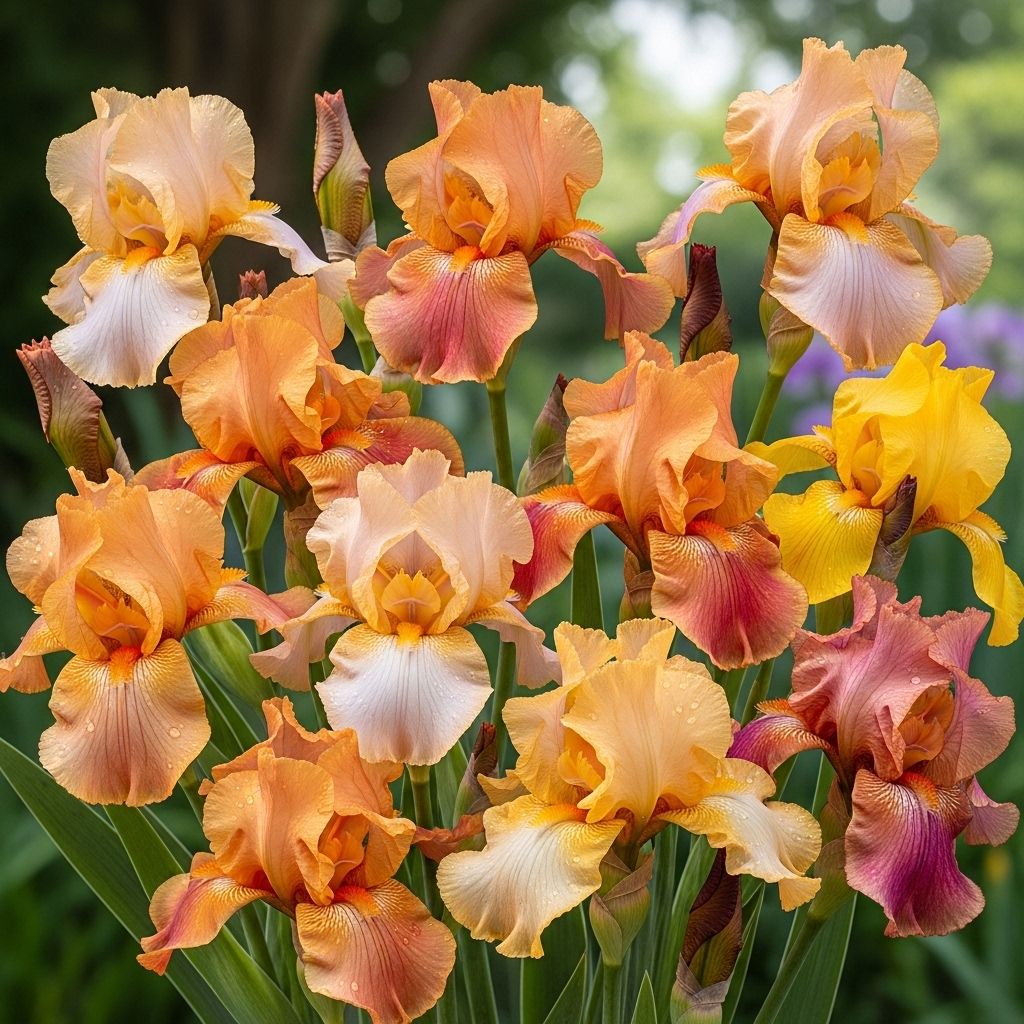Orange Iris Varieties: 11 Vibrant Cultivars For Your Garden
Discover 11 dazzling orange iris types, expert growing tips, and care advice for sun-drenched, colorful gardens.

Image: HearthJunction Design Team
11 Different Types of Orange Iris Varieties For Your Flowerbeds
Seeking to invigorate your garden with a brilliant pop of orange? The iris family boasts a remarkable spectrum of colors, with orange varieties gaining deserved attention for their bold, cheerful presence. With over 300 species and thousands of cultivars to choose from, selecting the ideal orange iris can elevate your flowerbeds from ordinary to extraordinary. In this guide, we profile 11 stunning orange iris cultivars, highlighting their features, recommended garden uses, and expert growing tips to help your garden stand out all season long.
The Allure of Orange Irises
Named for the ancient Greek goddess of the rainbow, iris flowers symbolize hope and creativity, making them beloved additions to garden landscapes worldwide. While purple and yellow are perhaps the most iconic hues, orange iris varieties offer unique vibrancy with their tangerine, apricot, and flame tones. Their dramatic ruffled petals and upright standards bring structure and color harmony to perennial beds, borders, and even containers. Whether you are looking to create a warm-toned oasis or accentuate cooler blooms, the orange iris is a versatile choice worth exploring.
Understanding Iris Types and Their Care
Irises are classified into several groups, most notably bearded and beardless types. Within these, you’ll find an incredible array of orange cultivars. Here are key points on general iris culture:
- Sunlight: Full sun is ideal for vibrant flowering and sturdy growth.
- Soil: Well-drained soil prevents rhizome rot and encourages healthy blooms.
- Water: Moderate; avoid waterlogged conditions.
- Spacing: Allow air flow to reduce disease risk and promote robust plants.
Proper planting depth and periodic division are crucial for long-term vigor. Bearded irises thrive when the rhizome sits just at or slightly above the soil surface, while beardless types may be set an inch or two below.
11 Orange Iris Varieties to Enliven Your Garden
‘Orange Splash’
| Botanical Name | Iris germanica ‘Orange Splash’ |
|---|---|
| Sun Requirements | Full sun |
| Height | 3 to 4 feet |
| Hardiness Zones | 4 to 9 |
A bearded German iris, ‘Orange Splash’ impresses with its large, tangerine-hued blossoms reaching up to 6 inches wide. Dramatic ruffled edges and firm upright petals create a striking visual, while the downward ‘falls’ reveal bright yellow beards and throats. Plant it behind purple companions, such as cranesbill or salvia, for maximum impact. This cultivar also makes a long-lasting cut flower, with blooms persisting for about 10 days.
‘Tiger Honey’
Known for its bold, honey-toned petals streaked with orange and gold, ‘Tiger Honey’ is a favorite among gardeners seeking a unique look. The falls are often more vividly colored, with intricate veining adding extra texture. This cultivar stands out in mass plantings or as a border accent.
‘Pumpkin Cheeks’
True to its name, ‘Pumpkin Cheeks’ displays round, softly ruffled blooms in deep pumpkin orange. Its sturdy stems support the weight of large flowers, making it suitable for cutting and floral arrangements. This iris blooms early in the season, providing a head start to your color display.
‘Orange Ade’
A show-stopping iris with clear orange petals and subtle hints of scarlet at the base, ‘Orange Ade’ thrives in full sun and well-draining soil. It performs best when paired with contrasting blue or violet blooms and is celebrated for its resilience and garden adaptability.
‘Copper Classic’
This variety features a rich, coppery-orange color with a golden sheen. ‘Copper Classic’ delivers a warm, autumnal feel and pairs beautifully with late-blooming perennials or ornamental grasses. It’s a reliable performer, known for strong stems and prolific flowering.
‘Orange Sultan’
‘Orange Sultan’ boasts dramatic, deep orange petals that almost gleam in direct sunlight. The ruffled edges and intense coloration make it a focal point in any bed or border. It blooms in mid- to late spring, extending the season of orange interest in your garden.
‘Enchanted Orange’
A compact cultivar, ‘Enchanted Orange’ offers vivid orange blooms with yellow highlights at the throat. Its moderate height makes it ideal for smaller gardens or front-of-border plantings. This variety is also praised for its disease resistance and reliability.
‘Mandarin Magic’
The luminous petals of ‘Mandarin Magic’ glow in shades of mandarin orange, occasionally with apricot undertones. Hardy and easy to maintain, this iris is a great starter for novices and a staple for collectors. Its upright habit adds vertical interest to flowerbeds.
‘Firecracker’
‘Firecracker’ is an aptly named iris, delivering fiery orange-red blossoms with subtle yellow accents. It is especially effective when planted en masse, creating a blaze of color that attracts pollinators and garden admirers alike.
‘Autumn Orange’
This late-blooming variety extends your iris season into summer and early autumn. With rich, burnt-orange petals edged in gold, ‘Autumn Orange’ bridges the gap between classic spring irises and the harvest hues of fall.
‘Tangerine Dream’
Noted for its dramatic, saturated tangerine color, ‘Tangerine Dream’ produces large, ruffled flowers on sturdy, upright stems. This variety often leads to second glances and is a standout in mixed perennial borders or dedicated iris beds.
Best Companions and Design Tips for Orange Irises
- Purple Flowers: Salvia, alliums, and cranesbill create striking contrasts.
- Soft Neutrals: Pair with white foxglove, silver lamb’s ear, or pale yellow daylilies for balance.
- Ornamental Grasses: Grasses offer a textural foil for iris foliage and blooms.
- Layered Planting: Use taller irises at the back of borders and compact varieties at the front for depth.
Orange irises also work beautifully along pathways, in mixed containers, or as cut flowers for indoor arrangements. Their sword-like foliage adds year-round structure, even when not in bloom.
Planting and Propagation Tips for Orange Irises
Site Selection: Choose a location with full sun and good air circulation. Avoid areas prone to standing water.
Soil Preparation: Amend heavy clay soils with organic matter; ensure excellent drainage. Sandy or loamy soils are best.
Planting Depth: Plant bearded iris rhizomes so that the top is just visible above the soil surface. Beardless types may be buried an inch or two deeper. Bulbous irises, such as Dutch or Spanish, should follow the instructions specific to their type.
Spacing: Allow 12-24 inches between rhizomes for good air flow and to minimize disease risk.
Watering: Water in well after planting, but do not keep the soil soggy. Established irises require minimal supplemental watering except during prolonged drought.
Fertilization: Use a balanced, slow-release fertilizer in spring. Avoid high-nitrogen products, which may reduce blooming.
Ongoing Care and Maintenance
- Deadheading: Remove spent blooms promptly to encourage further flowering and prevent seed set.
- Division: Irises multiply rapidly. Every 3-5 years, divide clumps in late summer or early fall to reinvigorate plants and prevent overcrowding.
- Foliage Trimming: After bloom, trim leaves to one-third their height to reduce pest and disease issues.
- Mulching: Use a thin layer of mulch to conserve moisture, but keep away from rhizomes to prevent rot.
- Winter Care: In cold climates, protect rhizomes with a light mulch after the ground freezes, removing in early spring.
Common Issues and Troubleshooting
- Rhizome Rot: Ensure soil drains well and avoid deep planting. Overwatering is a common cause.
- Leaf Spot: Brown or black spots usually caused by fungal pathogens. Improve air flow, remove affected leaves, and practice good garden hygiene.
- Iris Borer: Check for chewed foliage and mushy rhizomes. Remove and discard infested sections promptly.
Frequently Asked Questions (FAQs)
Q: When should I plant orange iris rhizomes?
A: The best time to plant iris rhizomes is in late summer to early fall, allowing roots to establish before winter. Spring planting is also possible in milder climates.
Q: How often do orange irises need to be divided?
A: Most irises benefit from division every 3 to 5 years, or when flowering decreases and clumps become overcrowded.
Q: Can I grow orange irises in containers?
A: Yes! Choose compact cultivars, use well-draining soil, and ensure pots have drainage holes. Water sparingly once established.
Q: Do orange irises attract pollinators?
A: Absolutely. Their vibrant colors and open blossoms draw bees, butterflies, and other beneficial insects to the garden.
Q: What companions look best with orange irises?
A: Cool-toned flowers (such as salvia, lavender, and allium), ornamental grasses, and other spring bulbs provide wonderful contrast and prolong the season of interest.
Conclusion: Bringing Orange Sunshine to Your Garden
Orange irises are more than just a fleeting spring spectacle—they offer enduring structure, color, and delight for gardeners of all experience levels. With so many enticing cultivars to choose from, you can easily find varieties to suit your growing conditions and design preferences. Thoughtful planting, regular division, and attentive care will ensure your irises repay you with vibrant bursts of color for years to come.
Consider the orange iris your garden’s new star performer—radiant, elegant, and full of sunshine.
References
Read full bio of Srija Burman












